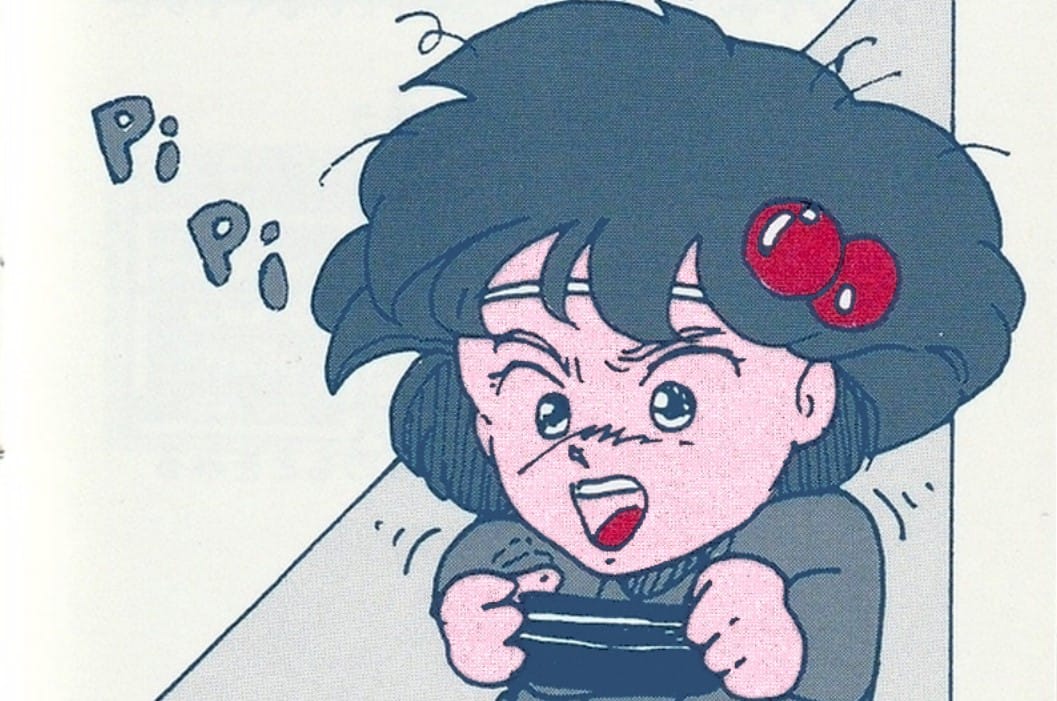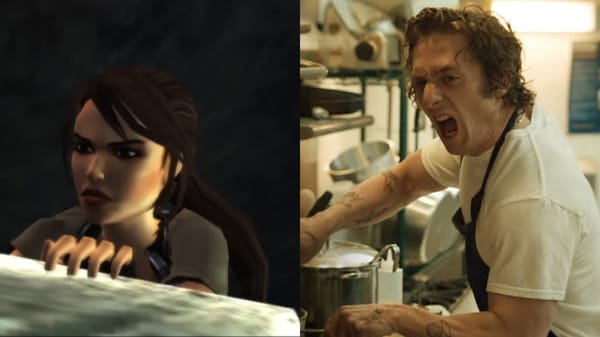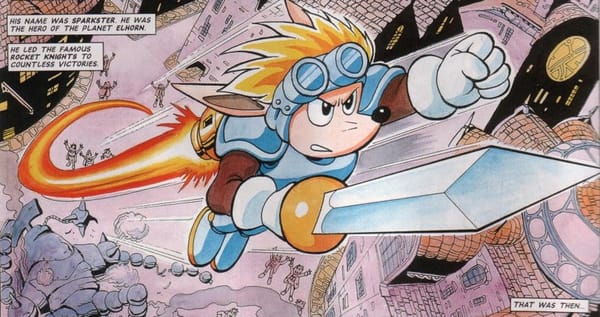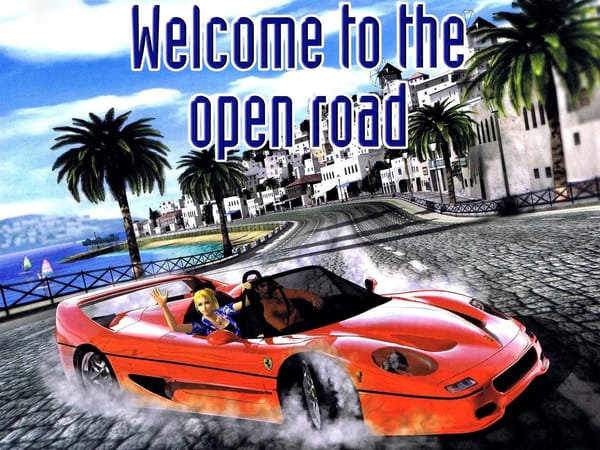How the Famicom’s ultimate “legendary shitty game” got translated after 36 years
And another fan translation: the much less shitty Samurai Shodown RPG is playable in English after 26 years, itself!

Now this: this is a good weekend, ROM readers. As I write this I’m getting buzzed on free cocktails at an airport lounge in Boston, my girlfriend just got a new job, and I’m en route to a week’s vacation in Portugal with my Analogue Pocket in tow. Supercharging said buzz: Loaded up on the Pocket I’ve got the brand new(!) and beautiful Goodboy Galaxy, a Game Boy Advance game released in the year of our lord 2023.
I have an interview coming on designing a new game to be played via emulation, but that’ll have to wait until next issue. This time, however, I did talk with the fan translator behind the English release of a “legendary shitty game” first released for the Famicom in 1987. She tells us why her passion for it is sincere and not just extreme dedication to a bit.
It’s really a joy to talk to the folks who make the emulation scene such a vibrant place and play a very small part in sharing their stories; I hope you enjoy reading about them as much as I enjoy putting them together. As always, I’d be grateful if you shared this with anyone you think would enjoy it, too!
The second of our Big Two is a shout-out to the translation of Samurai Shodown RPG featured below in the Translation Station! There was some other cool news in the emulation scene this week that I didn’t have time to dive into more deeply as vacation called, but you should definitely check out this short post about making the GBA E-Reader version of Mario Bros 3. playable again!
I don’t expect to be doing much gaming or game shopping in Portugal, but I do love having the memories of a trip intertwined with a particular book or game. When I was in high school, I spent at least 25% of a Hawaiian vacation with my dad reading paperback after paperback of the Star Wars: New Jedi Order series, which looking back was an embarrassing way to spend a week in one of the most beautiful places on earth but what can I say, I was an embarrassing 15-year-old and I was utterly absorbed by those books.
More topically, during a 2018 vacation with a childhood friend across Hong Kong and Korea I spent an hourish every night exhausted in hotel beds playing Mario Odyssey. I beat the entire game on that two week trip and I’m not sure I touched it since; my memories of it are so intertwined with traveling I don’t think I’ll ever touch it again unless I find myself back in Korea. (On that note, does anyone want to sponsor a Read Only Memo trip to the Busan International Film Festival in 2024? Hit me up if you have money to literally burn on my wildest fantasies).
All that’s to say, Goodboy Galaxy is clearly a game one should only play while watching the sun set over Lisbon or while sipping port in the Duoro Valley; retro-modern Game Boy Advance nostalgia is classy af.
Now at the risk of showing how the sausage is made, a couple photos that reveal I’m actually writing this final paragraph a full 36 hours after the rest of the intro (time isn’t real!!):

I made it to Lisbon, and apparently the games followed me.
The Big Two
1. How the Famicom’s ultimate “legendary shitty game” got translated after 36 years

It’s been a hell of a month for fan translations — off the back of Boku no Natsuyasumi 2, SNK’s Samurai Shodown RPG has been translated, too (see below), checking off another somewhat legendary game. But I don’t know if it’s as legendary as this Famicom game: Stargazers, aka Hoshi Wo Miru Hito, literally nicknamed “legendary shitty game” in Japan. It’s a bit of a cult classic, infamously impenetrable and poorly designed according to common consensus. It was re-released on the Switch a few years ago, with a promise of an official English localization… which never materialized. Other than an unfinished fan translation from 2008, it’s remained stuck in Japan ever since, which sounds like a perfectly fine fate for a legendary shitty game. But 15 years after that first aborted effort, translator Maude decided to come in and do it right — after playing through the game and “loving every second of it.”
“My first time seeing it in action was dowolf's fantastic speedrun for AGDQ, which shows off the game's peculiarities in a super entertaining way even if you aren't familiar with it,” Maude says. “Shortly after that they announced the Switch version, and I was like, oh I've gotta get on that ASAP. I would check obsessively for a release date, it might've legitimately been my most anticipated game of 2020. Then it dropped and I holed up in my room for a weekend beating it and came out a changed person.”
Maude started learning Japanese in middle school and is now a professional translator, but tackling Hoshi Wo Miru Hito came about after watching a Twitch streamer trying to play the original fan translation and struggling with its unfinished state; after one of her friends coincidentally also started playing it, she decided to give it a shot.
That half-finished 2008 job definitely left room for improvement:
“I won't sugarcoat it, most of it was outright wrong. I'm guessing it was someone with a rudimentary grasp of the language skimming it and guessing at what the lines mean. I'd be here all day if I went into specifics but the funniest one was a line where an old man says ‘atama ga bo-to suru’ – ‘[I'm] spacing out’ – which became ‘my mind thinks I'm rowing a boat’.
Maude told me that hacking Hoshi Wo Miru Hito actually proved to be pretty straightforward — I’d expected some devilish twist, considering the official translation never materialized and the original fan translator abandoned their project. But apparently it was fairly easy, with the translation taking just a few days and hacking just over a week in a hex editor.
Maude shared one particularly difficult bit to overcome as she picked up where the original hacker left off:
“The toughest part was figuring out why the ESP menu was showing incorrect names. I couldn't get to the bottom of it other than discovering it was caused by the method the hacker used to fit more text on screen, so I basically just… did some detective work to find out what he did and undid it, then changed some values around to squeeze more text onto one line without messing with the game's original logic. There was also an issue where in a single specific instance — the medicine names — the game does some crazy math on the ID number of the item to get the address of the string rather than using pointers like the rest of the game. So I had to do a simple hijack to make it use a pointer table instead. It was my first time rewriting code, so that was exciting! And also kind of pointless, since I realized afterwards that only one of the medicine names didn't fit within the original character limit. But I still felt like a computer genius. I'm sure it's all ridiculously simple to someone who knows what they're doing, but I'm speaking from a layman's point of view. A layman who counts on her fingers, at that. But a very headstrong one when it comes to throwing things at a wall until I luck into a solution.
Translation-wise, the only rough part was enemy and item names, which are all either intentionally misspelled versions of English words - like Paranoya — or incomprehensible blends of syllables that even the collective knowledge of the Japanese fandom didn't yield an explanation for, like Kariu. For example, one weapon is ‘desuteeta’ which could either be Death Theta or a mangled version of Devastator - I opted for Devastator, but if it were an official localization, I'd probably have gone with something more creative. It's considered part of the game's charm in Japan, but it doesn't translate well. I'd still like to know why one of the attacks is called Cat Shield, though. I saw a lot of theorizing but nothing conclusive.”
I asked Maude what it is, exactly, that makes Hoshi Wo Miru Hito worth the time — what captivated her about the game when she first watched and played it. She said its reputation is deserved, but at the same time there are definitely worse games out there. This one is just bad in a particularly special way.
“What makes it legendary is that EVERY aspect of it flies in the face of logic. It feels like it was designed by an alien. You're confronted with it basically the moment you boot it up with things like the invisible first town or the ESP menu (which you can't cancel out of) being the first option in battle instead of "fight". And the oddities just keep coming. When you think you've got the game figured out suddenly it's like, oh, I can just fly over walls now, okay. Oh money isn't shared between party members, sure. It has to be played to be believed.
When you think about it, it wouldn't have enough of a cult following to get a rerelease, or two fan remakes, or loads and loads of fanart, BGM remixes, etc if there wasn't "something about it" that makes it compelling. It's hard to say what it is, but it isn't purely irony. I think it always starts that way, wanting to get a few laughs out of it, but sooner or later it has you in its grip. People like kusoge for a lot of reasons, but mine is that they tend to have a kind of weird that you don't find in "good" games, and that resonates with my novelty-seeking brain. They break conventions that exist for a reason, and that's interesting! Say what you want about games like Death Crimson, Sonic 06, or Hoshi, but there's nothing else like them.”
You can find Maude’s translation here and follow her on Twitter.
Mind spreading the word about Read Only Memo? Send somebody a purple link.
2. Samurai Shodown had an RPG, and now it’s in English, too

Let’s gooooo! It’s a double dose of fun translation news this issue. A translation years in the making from Jeff Nussbaum, artist Combustocrat, hackers Justin Gibbins and Garrett Greenwalt, has brought SNK’s 1997 Neo Geo RPG to English for the first time. It’s a traditional turn-based RPG but with a bit of a fighting game twist, based on the stories of Samurai Shodown 1 & 2. “My white whale has finally been slain,” Nussbaum wrote in the game’s readme. The project goes above and beyond to improve aspects of the game in addition to the English text:
Bug fixes from the original Japanese, like some character portraits not being displayed
A healthy amount of original art, including a new font & title screen by combustocrat
Two variant patches, one for the TOSEC rip and another for the REDUMP rip
Quality of Life improvements, which can be toggled via soft DIPs, but are enabled by default in US/EU mode, or disabled for JP mode:
Choose between the original Neo*Geo CD or the PS1/Saturn version of the elements system
Improved potency of permanent stat boost items
Improved potency of Repellent item (temporarily lowers encounter rate)
Selectable alternate palettes. Hold D while pressing A when confirming any character selection until you hear a chime. Not dependent on soft DIPs.
You can hit up Nussbaum’s Ko-fi page if you want to toss a thank you his way for dedicating most of this year to bringing his white whale to the surface.
Patching In

PC-Engine Mednafen build updated - This dev-focused PC Engine fork includes “functionality updates for the PC-FX debug experience and several emulation accuracy focused additions for the PC-Engine/TG16 Module.” There’s a list of fixes that frankly go over my head but may be relevant to PC-Engine diehards!
PCSX2 fixes missing Depth of Field in Metal Gear Solid 2: Substance - Taking notes, Konami?
Another little update: PCSX2 FMV fixes - Rule of Rose, This is Football 2003, Clock Tower 3, and more.
Also, Alt+F4 now shuts down the emulator while in fullscreen, as it should in any PC application!
Dolphin Progress Report covers 3 months of updates - I’ve touched on some of the updates listed here already, like the added dark mode, but the Progress Report is always a great read and helps me learn new things about emulation.
There’s a great explainer in here about how Dolphin’s new resampling options work — this is essentially what’s happening to the rendered image of the game based on its resolution relative to your display resolution. “As far as we know no other game, emulator, or even GPU driver implements such an advanced and comprehensive resampler,” the blog says. Click over to it for tons of details and image comparisons.
Also, Dolphin’s rendering resolution dropdown now goes all the way up to 8K, wowza!
Yuzu Mario Wonder - Yuzu fixed up a few issues in Mario Wonder mentioned in its latest progress report, making sure everyone can get psychedelic on Android, PC or Steam Deck in addition to Switch!
A small but cool new feature: you can now create a shortcut from a game within Yuzu and add it to your desktop.
And something tantalizing for the future: “Blinkhawk is… working on a new project seeking to make the GPU process-agnostic, allowing multiprocess emulation within the GPU. No fancy names this time, we’ve simply been calling this “Multiprocess” internally. Multiprocess is a mandatory step towards UMA support, which will provide huge gains for iGPUs and SoC users, as well as reducing RAM consumption.”
Core Report

- Crazy Mazey MAMEy - MAME dev David Haywood highlights a cool addition coming in version 0.261 — support for a Pac-Man hack called Crazey Mazey. I have never heard of this game in my life but I like how it sort of looks like an fever dream combination of Centipede and Pacman. “It also runs on Galaxian hardware like some Pac-Man boots, and is heavily reskinned with new graphics and audio — basically masquerading as a brand new game,” Haywood tweeted.
Translation Station

Budokai 2? Cool. Budokai 2 V? Cooler - See, cuz, Frieza’s brother Cooler is playable in this version of Budokai… annnyway, this is pretty cool — a rare version of Budokai 2 for PS2, only released in Japan as a giveaway for V-Jump readers. Only 2,000 copies exist! It included quite a few changes from the original game, and started with everything unlocked. Man, this reminds me of just how damn good Budokai 3 was…
Mario Golf, but after - The translation of Camelot’s Game Boy Color golf game from 2001 hit RHDN two years ago, but it just got a couple nice updates. 20 years ago this game had online play (on the Game Boy Color!!) using a special cellular-connecting link cable. That service is obviously not still available, but the game offers the same great RPG golfing as Mario Golf. Here’s what the patch notes add, according to the readme:
Lots of text and graphic additions and tweaks thanks to Darkshade and Ryuzac from REON Team!
Fixed a major crash when leaderboards showed up
Akanbe Dragon is not what I expected - Here’s a strategy game from the future developers of Super Robot Wars making a strategy game “based on a cookie by House Food, who used to sell ‘Akanbe Dragon’ teriyaki and ‘Shiranbe Salamander’ cheese flavored cookies in Japan in the 80s.” 😵 I don’t know if even the most hardcore Super Robot Wars fan would want to play this, but I am presenting it to you because it is a wild thing that exists.
Good pixels

Since I’ve been playing some Goodboy Galaxy on my Analogue Pocket, I figured I should share some screens!
And I’m absolutely loving these off-screen shots of the SamSho RPG posted on the SegaXtreme forums.



